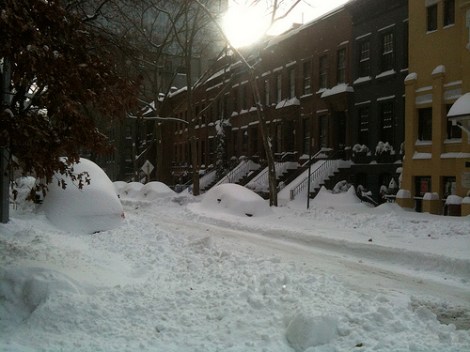Watching the news last night, Diane Sawyer leaned into the camera with a what’ll-they-think-of-next expression on her face to introduce a story straight out of Ripley’s: Climate change may mean less snowfall but more blizzards. [record scratch sound effect] Say whaaaaat?
Philly.com ran the story with the headline, “Less snow, more blizzards makes sense to scientists.” Outlets that ran the Associated Press’ story used, “Climate contradiction: Less snow, more blizzards.” Now I’m not the smartest person in the world, I’ll grant you that, but I find it hard to believe that adult human beings who understand English and have experienced weather are having trouble with this concept.

A blizzard in Manhattan, if that makes sense.
The AP explains the idea:
A warmer atmosphere can hold, and dump, more moisture, snow experts say. And two soon-to-be-published studies demonstrate how there can be more giant blizzards yet less snow overall each year. Projections are that that’s likely to continue with manmade global warming. …
Ten climate scientists say the idea of less snow and more blizzards makes sense: A warmer world is likely to decrease the overall amount of snow falling each year and shrink the snow season. But when it is cold enough for a snowstorm to hit, the slightly warmer air is often carrying more moisture, producing potentially historic blizzards.
“Strong snowstorms thrive on the ragged edge of temperature — warm enough for the air to hold lots of moisture, meaning lots of precipitation, but just cold enough for it to fall as snow,” said Mark Serreze, director of the National Snow and Ice Data Center. “Increasingly, it seems that we’re on that ragged edge.”
Even beyond consideration of the “ragged edge” of weather conditions, the concept is not that complex. Consider last year’s drought. It was still a drought even if there was a thunderstorm on the Great Plains one day. Or consider, you know, your life experience. If your boss suggested that he would cut your pay in half but double the number of bonuses you receive — you wouldn’t be happy about that, but the mechanics of the proposal make sense to you. And you probably understand how that would result in your having less money over the long-term.
There are three reasons the story has been covered as it has, I suspect. The first is that there are probably people who don’t really understand the difference between a blizzard and a snowstorm. That’s fine.
The second is that playing up the contradiction is a hook for the media, a tease for readers and viewers who should actually be insulted at being patronized. Given how little coverage of climate change there has been over the past few years, it makes sense that people might need a bit of a ramp into a story about a specific component of the issue. But offering it as a “what’ll those wacky scientists think of next!” sort of story does a disservice to the scientists and the viewers and the media outlet. Two of those parties deserve better.
And the third reason it’s been covered like this: That’s how climate change deniers want it. Conservative websites ran far deeper with the apparent contradiction than the obvious science, as they do. Part of their tacit mission is, of course, to undermine climate science and scientists across the board. So they seized on a variant on the it’s-cold-so-what-about-global-warming response: It’s snowing, so what about that idea of less snow? Which is what makes Diane Sawyer’s aw-shucks treatment of the story so frustrating. It suggests that the concept is confusing — as well as the science. Adults can handle complexity, but they have real trouble with obfuscation.
After the climate story, Sawyer then reported on the hacking of Burger King’s Twitter account. That story didn’t faze Sawyer at all.




